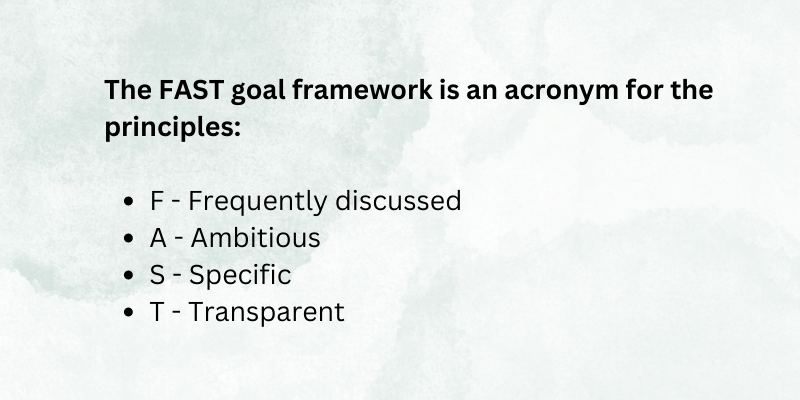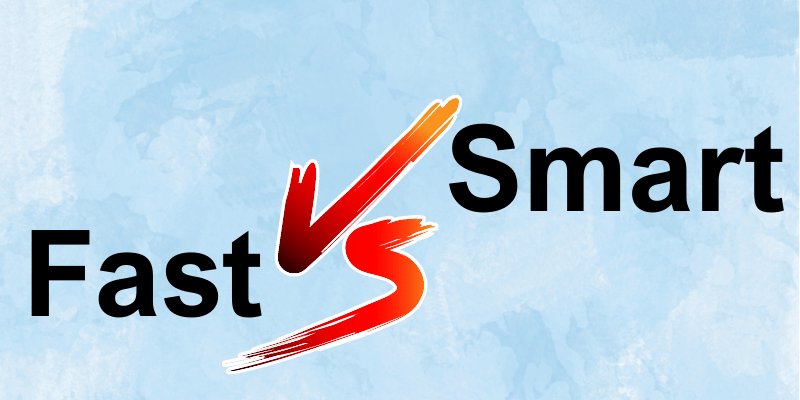The prior principle for good management of a team is goal-setting. Among the techniques based on Peter Drucker’s theory, the fast goal and smart goal were invented.
As a matter of common sense, organizations use the Smart framework for employee performance management. But even though this method is proficient in achieving those goals, it limits team performance.
On the other hand, fast goals provide a cooperative sense.
By articulating what the business aims for and what employees can offer to achieve it, this strategy’s success and reputation are noticeable.
All things considered, I invite you to join us to reflect on both techniques, considering their positive and negative effects over personal and organizational scopes.
Are fast goals better than smart goals?
Although the Management by Objectives principle predicted objective goal setting and feedback; it never considered the high demand for the technique in worldwide business. Smart goals gained popularity for their practice and organization in corporate goals accomplishment.
After years of implementation in enterprises’ strategy execution, many managers still consider this strategy effective. But it is important that the managers ask themselves: Does it produce the desired outcomes or have we just settled down to this model?
What are SMART Goals?


A smart goal is a technique of setting objectives to produce possible metrics and milestones — such as OKR (Objective and Key Results) — through a realistic and specific set of targets worked mostly individually.
“SMART” is an acronym for the 5 principles for project managers:
S – Specific
M – Measurable
A – Achievable
R – Realistic
T – Time-bound
All these elements generate a technique that envisions accomplishing the company’s aim by considering personal capabilities; meanwhile presenting specific and transparent goals. Alongside this, it is fundamental to implement reasonable deadlines.
The best way to implement SMART in a business is to create goals that attend every method criterion. The more specific the targets, the clearer the objectives will be for employees to achieve.
It may seem effective — and still considered so by many entrepreneurs —, but this technique has its own limitations that damage team performance.
Pros and cons of the smart method


The strongest point of this goal-setting framework is the realistic objectives.
And, since it focuses on results within a reasonable time, it is adjustable to each employer’s work style.
Smart goals bring a minimum level of teamwork, delegating functions for each employer to work individually in favor of achieving the company goals.
Even though it might be considered an advantage, the individual scope of this tactic causes problems in the alignment of steps between the teams. The lack of interaction among the steps impedes effective teamwork performance and the possibility of a better result.
Also, most times, the employees stick to their tasks, limiting their potential. This limitation — the cycle of individual and time-bound targets — may result in a loss of motivation and mine a sense of ambition.
As a solution to the Smart technique cons, the FAST goals method was developed.
Introducing FAST goals
In a 2018 article written by Donald Sull and Charles Sull — professors at MIT Sloan School of Management — a deep analysis of the goals strategies of enterprises such as Google, Intel, and Anheuser-Busch InBev, they noticed the necessity of updating the old goal setting approach.
Pioneers in the new management strategy based on goals and metrics to optimize production and performance; these enterprises inspired the MIT Sloan management review of the method’s academic definition.
What are fast goals?
Fast goals are a technique for organizational management, which is mainly focused on frequent discussions, dynamism, and transparency among collaborators.


The FAST goal framework is an acronym for the principles:
F – Frequently discussed
A – Ambitious
S – Specific
T – Transparent
This is a technique thought to supply necessities that smart goals lack, such as competition, cooperation, and frequent monitoring.
Some examples may include:
- Qualify 10 interns for the Junior position within 6 months
- Grow Instagram activity within 3 months in order to duplicate the followers’ number
- Develop a new marketing campaign every three months
How Fast improves on Smart?
Considering that fast goals are an improvement of its previous management strategy, clearly, this technique is considered to be better than smart goals.
While smart technique focuses on achieving settled results and targets, fast pursuits bring their performance to the next level.
To solve the problem of lack of motivation, the Fast method seeks to set ambitious tasks. Being ambitious is an invitation for each employee to exceed their limits and achieve better performance.
Other than being an annual cycle, the FAST method aims to be an interactive process. It influences employees and managers to engage in ongoing discussions throughout the year — ideally consisting of trimestral revisions.
High levels of communication and transparency among the company members lead to better engagement at work. This dynamic environment boosts workers to push their performance and outperform others merely for self-satisfaction.
Using the fast strategy effectively, encouraging the engagement and constant communication of specific objectives between co-workers leads to the desired outcomes and fulfillment more significantly than smart methods.
Fast vs Smart


So far, it is clear that the updated version of smart goals is a success. Meanwhile, fast goals are better applied to teamwork due to their transparency over business goals; smart goals focus on an individual sphere. But how to know the difference between them when applying?
Frequency vs Time-bound
Working within a set deadline for accomplishing a task may be easier when working alone. However time-bound goals do not consider unforeseen events in teamwork, disturbing the project’s progress.
The frequent verifications and communication via individual and team meetings ease the handling and prevention of unexpected events. Besides, using present work as a measurement of progress elevates growth.
Also, the team’s alignment is needed to keep track of the hits and misses. That’s important so each member can decide — independently and collectively — their next steps.
Ambitious goals vs. Achievable goals
It might not seem like it, but achievable goals limit the potential. Setting goals that are certainly accomplishable is convenient for the employee, leading to resignation and a lack of ambition.
Ambitious goals, otherwise, are intentionally not meant to be 100% completed. The higher the target is set, the harder workers will try to achieve it. All eager for victory also promotes healthy competition among the teams.
Transparency vs Relevance
Considering that it becomes easier to align personal objectives with the team objectives, transparency is fundamental to motivation. Besides, it elevates individual performances growth and cooperation.
The feeling of belonging and personal satisfaction is heightened by the feeling of significantly contributing to work.
Meanwhile, the lack of transparency causes misunderstanding among team members, leading to possible disagreements, which can deeply affect the project.
Businesses and managers must acknowledge the importance of working with relevant objectives and individual feedback, besides having transparent goals during the process.
Implementing F.A.S.T. Goals for teams
Some platforms already provide tools for FAST goal setting, but it doesn’t mean that it is impossible to do it by yourself following simple guidelines.
Setting Goals – FAST Method
Firstly, it is important for the manager and the team to gather and discuss goals for the project. Make sure the goals are fully understood by everyone at the meeting.
After the alignment of the objectives, brainstorm about how to apply the FAST system to each task. Be sure that each member completely understands the meaning behind the technique and how it can work inside its parameters.
A technique that might help to ease the process is to set small tasks instead of a single bigger one; it can increase the feeling of productivity and, consequently, well-being.
Most importantly, always keep on track of the progress so everyone walks towards the same objective.
Tracking and Monitoring Progress


Through frequent discussions and meetings with the teams, it is possible to keep track of the progress. Giving the freedom for the members to interact and get together is also a possibility.
Be sure to include the needed constant feedback, resource allocation, and prioritization shifts. All those elements together might help to keep track of progress and lead to desired results sought by the company and team goals.
To make the monitoring easy, we already have technologies that assist business routines. Softwares such as Fellow, GoalsOnTrack, Weekdone, and Trackstar were created to assist the goals management, providing a better organization; and creating the same impact as person-to-person tracking.
Benefits for team performance
Most businesses use private and individual goals on a daily basis. Public, transparent targets are used for workers to follow each other’s tracks, promoting interaction in favor of a common objective. The group and management brainstorming promotes creativity and logical thinking. Frequently discussed ideas and progress can lead to unexpected results that can benefit the enterprise. As said: Two heads are better than one.
Further, the constant meetings guarantee that nobody is left behind and every part of the project is aligned with the best interest.
Potential Pitfalls to Avoid with F.A.S.T. Goals
When implementing FAST goals, be cautious about some pitfalls that might happen. Even a small mistake can reflect negatively on the team, causing disappointment and demotivation; causing negative impacts on the overall performance.
Unrealistic Scope
Ambitious goals are important, but keep in mind that they need to be possible to accomplish at some point. Consider the reality of the company; its resources, capabilities, and constraints.
Unrealistic goals cause demotivation and frustration since, no matter the strategy, they won’t be achieved. Remember: realistic means attainable, and should have reasonable deadlines.
Lack of Buy-In
The goals should be aligned not only with teams but also with the values of the company. The main reason for employees to agree and accomplish the goal setting is because they are conniving with the culture.
A good idea has to have the support of the involved ones, respecting their opinions and feedback. If there’s no buy-in to an idea, rarely it is going to thrive. You must have a supporting team working for the same objective.
Losing Focus
When dividing a big task into smaller ones, it may happen to split the focus into too many simultaneous tasks. The lack of organization of tasks won’t lead to desired results.
It is important to set priorities and focus your energy on one goal at a time.
Dealing with things separately and giving full attention to each topic prevents mediocre results, yet promotes general satisfaction.
Fast Goals vs. OKR
Beyond the frameworks seen so far, there is OKR.
Unlike the title suggests, this is not a ‘this or that’ choice. While Fast goals are a goal-setting technique, OKRs are a goal-setting framework. Combining these tactics it’s possible to enhance the organization of a company and overcome performances with ambition, specificity, and transparency.
Mixing the technique with the framework will make the organizational objectives easier to achieve. Also, the alignment of personal and team goals will keep the organization agile and capable of adjusting to any condition.
What are okrs?
Created by Intel’s CEO, Andy Groove; OKRs — or Objectives and Key Results — are a goal-setting framework used to administer performance management inside companies. It is an adaptive and simple method that brings focus, transparency, and alignment to enterprises and their management strategies.
Similarly to smart goals, this strategy focuses on setting targets that need to be fulfilled within a deadline. Each key result will determine the progress of the Objectives; yet, OKRs can present initiatives to determine Key Results.
Performance management with Okrs
Since the method aims to define clear and measurable goals, it is perfectly reasonable to use it strategically at a company. OKR is a method highly used by well-known enterprises, such as the famous streaming service Netflix.
To keep spirits up and not demotivate employees, it is indicated to set 3 to 5 goals to be achieved. Each qualitative objective is followed by quantitative key results. It permits a constant measurement of individual and team progress when needed.
Beware: Do not mistake OKRs with KPIs. The Key Performance Indicators are not a method, but they lead to the Objectives expected.
Considering all the information, the most indicated method for enterprises is the FAST, due to its dynamism, objectivity, and collaborative scope.
Smart goals are useful apart from the cons. Due to its nature, instead of applying it to the organizational culture, perhaps it would be ideal to use it for individual works or personal life would suit better.
In order to enhance your FAST technique, don’t forget to implement OKR; it will bring results that benefit the organization. Little by little, profits and satisfaction will be a constant in your organization.
Overcome your SMART management attitude. Bring your team to the next level, and substitute the past for the future.



